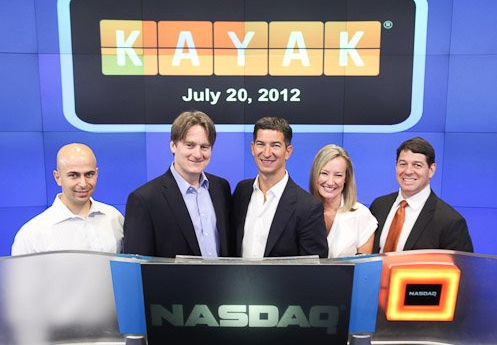It’s been a long time in coming. After first filing to go public in late 2010, Kayak finally came to market today debuting as a public company on NASDAQ, trading under “KYAK.” The travel bookings company has hit its fair share of bumps along the way, thanks to unsteady market conditions, erratic earnings, and a departing CFO.
All that has been washed away over the last 48 hours (at least for the time being), as Kayak exceeded the original $21 to $25 price range it set, raising $91M and opening at $26/share this morning. Not only that, but at the close of its first day as a public company, Kayak’s shares have jumped nearly 30 percent, finally resting at $33.18.
While it’s not the $115B market cap Facebook opened with, Kayak’s first day performance gives it a market capitalization that is nothing to scoff at — and makes just a tiny bit more sense. The prospectus shows that Kayak has 38.5 million shares outstanding after its IPO, giving the company a market cap today of just about $1.27 billion. Of course, those 38.5M shares don’t include the 9M stock options that can be exercised over the years. So, if you agree with SeekingAlpha, there’s going to be some dilution and after private placement, etc., that number could rise to $41.5M, potentially raising market cap to $1.36B.
Either way, not bad for a day’s work. And not bad considering the company was posting a net loss a year ago. However, in the first quarter, Kayak turned that frown upside down, posting Q1 net income of $4.1M and grew revenue by 39 percent to $73.3M.
While it was a great day for the company, Kayak definitely still has a lot to worry about. Personally, I like Kayak a lot and use it consistently. However, I’ve also started to use Hipmunk to complement Kayak, and if I could get Hipmunk to change a few things, it wouldn’t be unreasonable to see myself switching over full-time. I’m sure some other readers may be in a similar boat.
So there’s competition from sites like Hipmunk (and potentially from companies like Superfly, which Kayak’s departed CFO now advises), or perhaps a more salient threat will come from Google. Er, Google Travel. Google bought ITA, which happens to be the same travel search provider that Kayak bases its results on. And, really, just about everyone else.
Of course, look, right now there’s not going to be huge, huge variations in the results from these different sites. Most of them use ITA, and every day there’s one less airline, so there is a limit. Granted, the next generation of travel sites will (like everything else on the Web) eventually offer a far more personalized/tailored search experience, better deals, will be more intuitive and mobile, rather than bland, desktop-first, commoditized product experiences.
But until then, this really comes down to the interface. It’s all about who can offer the fastest search and the most options/permutations for travel search in the most simple layout. These companies make money on lead-gen, but really they should look and act like smart CRM tools. And just because Google owns search, doesn’t mean it’s going to own travel search. It’s an easy case to make, but there are also all kinds of competitive advantages in not being Google, focusing purely on travel search and the experience, discovery of travel, and focusing on the mobile piece.
Sarah wrote a great summary of Kayak today, so we won’t go over the same ground again, but Kayak finally started really paying attention to its mobile products at the end of last year, updating its UI across mobile and Web, and that (along with direct booking) seems like it’s beginning to pay off.
Don’t mean to keep editorializing here, but I’m under the impression that things like travel search will continue to become more and more popular on mobile devices. That changing user behavior isn’t going to suddenly stop. So, when looking at these companies, it makes one feel crazy when one gets the impression that travel companies don’t totally get that — or that they need to be creating meaningful travel profiles for people and doing this intuitively themselves, not relying on the user to hand over their social security number et al. Mobile is already favored over desktops in international markets, and that’s where these companies are going next anyway.
It’s also tiring to see travel companies be slavish to airlines. Yes, we understand why keeping airlines happy is essential to Kayak, but until I see Delta aggregating JetBlue and American’s ticket prices and flight times and sending users off-site when they don’t have competitive offerings, airlines will continue to need sites like Kayak. Maybe that can be some incentive to start focusing more on the end user.
Anyway, that part of the rant is over. As to Kayak’s market cap? It seems pretty fair. It will probably come down a bit in the near term, because, sure, it needs to begin posting larger gains to really feel like a $1B company. But compared to other public travel sites, like TripAdvisor, it doesn’t look bad, it’s just a matter of whether it can continue growing consistently with reduced margins.
Time will tell, but still a great day for Kayak. As it was for Palo Alto (which also went public today) — read Alex’s coverage here. Oh, and also worth mentioning that a continued good showing from these two companies could go along way towards rejuvenating the IPO market, which has struggled since Facebook did a cannonball/bellyflop, removing most of the water from the pool.
Excerpt image from Nasdaq

